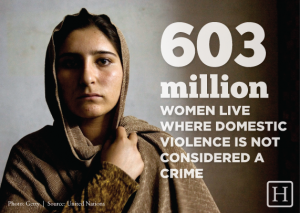Arab Immigrants face domestic abuse issues similarly to domestic abuse in other American homes. Arab women who recently migrated to the United States are dependent on their husbands who usually have been living in the U.S. for a long period of time. Normally, if women are not well educated in their home country, they will have limited English language skills and thus limits their ability to get a job or have an independent income. This barrier puts women at a greater disadvantage to their husbands who are familiar to American systems.
Arab women are more susceptible to varying types of abuse and are unable to leave their situation based on their current immigration status. Firstly, there are abuses that plague the Arab home more so than in the American home,including:
Women barred to the confines of their home: This may not seem like an abuse, but, when a husband does not allow the woman to leave her home at her own will she is imprisoned. This is something rooted in patriarchal tradition, where women should not leave the home without a spouse or male relative. The reasons why a spouse may not want his wife to leave the home is to keep her from absorbing American culture, and will tell his wife lies about the community in order to keep her indoors. Another reason may be to keep her from the education system, which could threaten the husbands superior standing in the family.
Abuse by withholding documents: This is a very interesting form of abuse. Withholding documents is not a physical abuse but men will use this as a way to threaten his wife. For example if a wife “misbehaves” her husband can hide her passport, licenses or I.D.’s, etc., in order to ensure she cannot leave him.
There is also the problem of immigration status. Battered women are financially dependent on their husbands and are more often then not have their immigration status sponsored by their husbands. This prohibits women from becoming financially independent. Men may also threaten to deport their wives, threaten to stop petitioning for their citizenship, and lie about their rights.
In cases where women are illegal or undocumented they cannot, or are afraid to, reach out to social services for assistance. If the spouse finds out about his wife reaching out for help he can have her deported or sent back home to her family, thus bringing with her shame. Research states that migration status is a profound determinant for women in abusive situations. This is associated with higher rates of spousal abuse. 1
In Law Abuse: This type of abuse in not always condoned by the husband, however this implies that the abuse is done by the husbands family onto his wife. In these situations the wife is new to the country and is usually uneducated and undervalued by the husband’s family. The in-laws treat the wife as a servant and this usually happens when the husband is out of town or if the husband lives in an other area for work. The abuse may continue with the husband.
Sexual and Verbal Abuse are also common types of domestic abuse. Men who follow the traditions of patriarchy may feel it is their right to have sex with their wives at any time they please despite the wife’s permission. However this is common in all cases of domestic abuse amongst immigrants and American born natives.
Physical abuse will also have cultural characteristics. Female Genital Mutilation is common amongst many families keeping this tradition. It is done usually with teens to mark their transition into womanhood, but can also be done in brutal ways as punishment or wrong doing. 2
Men may also use dishonor and shame as a form of abuse. This includes the use of a woman’s family as leverage, threatening to tell the family of her dishonor or undermining the woman’s authority as a mother. Men may publicly shame their wives, have public or private beatings, and may bring other members from the community in on the shaming and beatings. 3
Children can be used as a control tactic. This can range from a husband threatening to hurt his children or to take them away from their mothers. An example specific to the Arab community is an abusers attempt to keep their wife in the marriage by saying a divorce would lead to their daughter(s) being undesirable for marriage due to the mother breaking up the family. 4




